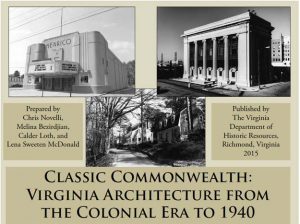Subscribe to DHR’s Newsletters!
Note: To read or download a PDF publication, Adobe Acrobat Reader must be installed on your computer.
Ordering Publications:
To order any publication, please contact the Archives Assistant by phone at (804) 482-6440. Archives will confirm the costs of any publication(s) ordered including tax and shipping for your order. You will then need to submit a check to DHR. Upon receipt of your order and check, your publications will be sent out. DHR is unable to transact book orders and sales online with credit or debit cards.
To access an online publication, scroll down or click on a bulleted link below to navigate to a description of publication, then click on title to access PDF for publications available online:
Publications:
- Archaeology
- Archaeological Research, Technical, and Survey and Planning Reports (follow link to a list of publications)
*
- Archaeological Research, Technical, and Survey and Planning Reports (follow link to a list of publications)
- Architecture and Survey Publications
- Cost Share Survey Reports (link goes to Archives / Special Collections)
* - Research and Guidance Publications
- A Handbook and Resource Guide for Owners of Virginia’s Historic Houses (10 mb PDF)
- How to Research Your Historic Virginia Property
- Interpreting the Standards (Technical Bulletins for Federal Tax Credits)
- Preservation Briefs
- Technical Assistance Reports and Updates (from DHR)
- Virginia’s Historic Registers: A Guide for Property Owners
*
- Books and General Interest Publications
- First People: The Early Indians of Virginia (2nd Edition)
- A Guidebook to Virginia’s Historical Markers
- A Guidebook to Virginia’s African American Historical Markers
- Jordan’s Point, Virginia: Archaeology in Perspective, Prehistoric to Modern Times
- Notes on Virginia (annual issues: 2000-2009) see below
- Notes on Virginia. A Special Commemorative Issue (2016), Celebrating 50 Years of Preserving Virginia’s History. This issue looks the history of preservation in Virginia, with an eye toward the 50th anniversary of the National Historic Preservation Act and Virginia Open-Space Land Act. (Bound copies of the 50th anniversary issue are still available.)
*
- Agency Reports and Guidance Documents
- Biennium Report on the Stewardship and Status of Virginia’s Historic State-Owned Property, 2021-2023
- DHR Work Plan Summary, October 2020 through September 2021
- DHR Strategic Plan 2018-2020 (this link leads to another website)
- Virginia’s Comprehensive Historic Preservation Plan, 2022-2027
- One DHR Plan, 2023
Archaeology Publications
Follow the link for online Archaeological Research, Technical, and Survey and Planning Reports
Architecture and Survey Publications
Classic Commonwealth: Virginia Architecture from the Colonial Era to 1940: This online publication is designed to aid professionals, students, and readers of all walks in identifying and documenting the numerous types and styles of historic buildings in the Commonwealth. The guide opens with an overview of Virginia’s architectural heritage within the context of larger historic trends, from its colonial-era settlement through to the economic, technological and cultural innovations of the early 20th century. The majority of the publication consists of “Style and Form” information sheets offering basic information about and character-defining features of the many historic architectural styles that have shaped Virginia’s public and private spaces across more than three centuries. Because architecture is a visual medium, Classic Commonwealth relies heavily on photographs which exemplify or illustrate relevant styles. This guide will enrich one’s understanding and appreciation of Virginia’s historic architecture. Additionally, the guide complements the New Dominion Virginia Style Guide (see below), which DHR issued in 2014. That guide covers the 1940s through the late 20th century.
 New Dominion Virginia Architectural Style Guide: The New Dominion Virginia Style Guide assists historic preservation professionals, local governments, preservation advocates, students, and interested members of the public with defining and documenting the numerous types and styles of post-WW II architectural resources in Virginia. Additionally, the guide offers an overview of the major historic and architectural trends in Virginia from 1946 to 1991 and instructions on improving entry of survey data in DHR’s Virginia Cultural Resources Information System (V-CRIS).
New Dominion Virginia Architectural Style Guide: The New Dominion Virginia Style Guide assists historic preservation professionals, local governments, preservation advocates, students, and interested members of the public with defining and documenting the numerous types and styles of post-WW II architectural resources in Virginia. Additionally, the guide offers an overview of the major historic and architectural trends in Virginia from 1946 to 1991 and instructions on improving entry of survey data in DHR’s Virginia Cultural Resources Information System (V-CRIS).
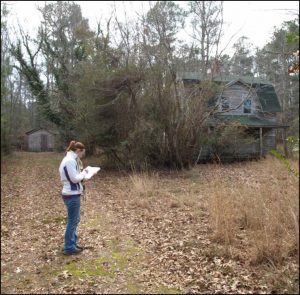
Guidelines for Conducting Historic Resources Survey in Va. (Revised in 2017). This document is often referred to as the “Survey Manual.”
Research and Guidance Publications
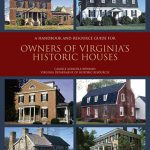
A Handbook and Resource Guide for Owners of Virginia’s Historic Houses (10 mb PDF)
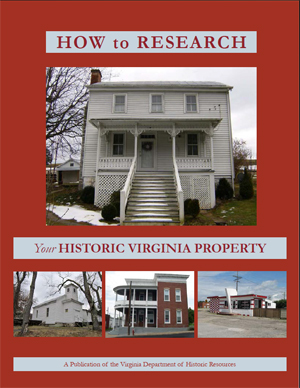
How to Research Your Historic Virginia Property (Updated 2013). Owners of old Virginia houses, commercial buildings, mills, and farmsteads, as well as historians of churches, schools, and businesses often want to learn more about the history of their property but are not sure how to go about it. DHR recently updated our publication on how conduct research on a historic property, available for downloading as a PDF. This publication introduces you to some of the useful sources available for learning about the history of a Virginia property.
Interpreting the Standards Bulletins. Prepared by the National Park Service, these bulletins explain rehabilitation project decisions made by the National Park Service in its administration of the Federal Historic Preservation Tax Incentives Program. The bulletins are case-specific and are provided as guidance only. They are not necessarily applicable beyond the unique facts and circumstances of each case.
Preservation Briefs. These in-depth reports prepared by the National Park Service provide valuable technical information and tips for important aspects of historic rehabilitation. Follow the Preservation Briefs link to the National Park Service Website for downloadable PDF versions of the briefs. Most Preservation Briefs also are available in print format from the Department of Historic Resources. For more information, go to the SOI’s Standards.
Technical Assistance Reports and Updates. For help with the hands-on challenges of historic rehabilitation, these reports and updates, many prepared by DHR staff, provide technical assistance summaries on common problems that arise in maintaining and rehabilitating a historic property. Please also see Preservation Briefs.
Books and General Interest Publications
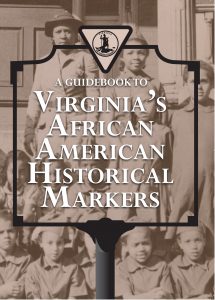 Compiled by program staff at DHR, A Guidebook to Virginia’s African American Historical Markers ($12.95) features the texts of 309 markers erected along Virginia roadsides within the past 40 years, including markers approved through June 2019 by the Virginia Board of Historic Resources (VBHR), which is authorized to designate new historical markers. The book is available through local bookstores and online book retailers. It is also available from the University of Virginia Press (www.upress.virginia.edu), the book’s distributor. Read more about the book. Also, since this book was published, DHR approved 76 new markers related to Black history in Virginia. Check out this supplement you can print at home that covers the new markers.
Compiled by program staff at DHR, A Guidebook to Virginia’s African American Historical Markers ($12.95) features the texts of 309 markers erected along Virginia roadsides within the past 40 years, including markers approved through June 2019 by the Virginia Board of Historic Resources (VBHR), which is authorized to designate new historical markers. The book is available through local bookstores and online book retailers. It is also available from the University of Virginia Press (www.upress.virginia.edu), the book’s distributor. Read more about the book. Also, since this book was published, DHR approved 76 new markers related to Black history in Virginia. Check out this supplement you can print at home that covers the new markers.
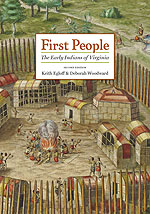
First People: The Early Indians of Virginia (2nd Edition) (1992, 2006) by Keith Egloff and Deborah Woodward. Incorporating recent events in the Native American community as well as additional information gleaned from publications and public resources, this newly redesigned and updated second edition of First People brings back into print this concise and highly readable narrative. Full of stories that represent the full diversity of Virginia’s Indians, past and present, this popular book remains an essential introduction to the history of Virginia Indians from prehistory to the present day. The book is available through DHR, the University of Virginia Press, or local bookstores.
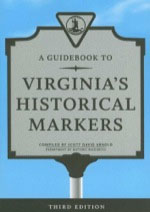
A Guidebook to Virginia’s Historical Markers (2007, University of Virginia Press). An excellent source for traveling or browsing at home. Includes nearly 900 markers and replacement markers installed along the commonwealth’s roadways since the last edition of the guide was published in 1994. This third edition of A Guidebook to Virginia’s Historical Markers brings together and updates the texts of more than 1,850 official state historical markers placed along Virginia’s highways since 1927. Divided into six geographic-cultural regions, this edition contains maps and three individual indexes that assist the reader in locating markers by title, number, or subject matter. Available through bookstores or the University of Virginia Press.
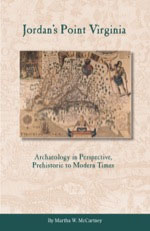
Jordan’s Point, Virginia: Archaeology in Perspective, Prehistoric to Modern Times by Martha W. McCartney. Jordan’s Point, a nearly triangular promontory in the James River, is situated in Prince George County, just east of the confluence of the James and Appomattox Rivers. In 1607, when the first European colonists saw Jordan’s Point, it was graced by the homes and cleared fields of natives they would call the Weyanoke. Virginia colonist Samuel Jordan established a community called Jordan’s Journey around 1621. In time, the settlement became a hub of social and political life. By 1660, Jordan’s Point had come into the possession of the Bland Family. This richly illustrated book tells the story of Jordan’s Point, which spans thousands of years, through the cultural features that archaeologists have unearthed there. It is available from the University of Virginia Press or local bookstores.
Notes on Virginia: No longer published, this former annual journal of DHR reported on Virginia historic preservation matters, and included listings of recent historic properties named to the Virginia Landmarks Register; historical highway markers approved for placement; easements donated to the Commonwealth; and other programs. (For copies of current or available back issues, contact us (Choose “General Questions in the Contact Form.“).
. Issues 2002 through 2009 are available as PDFs here.)

